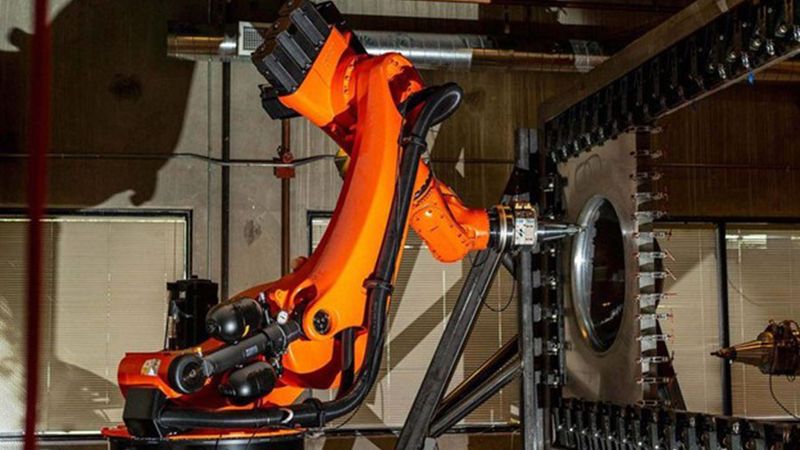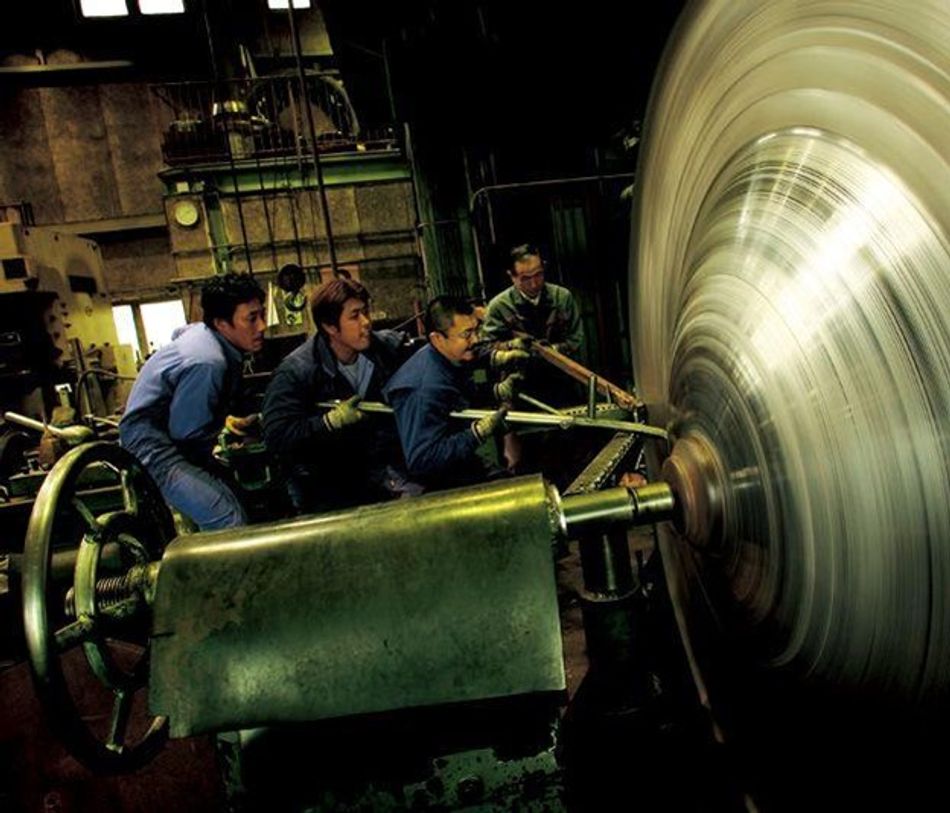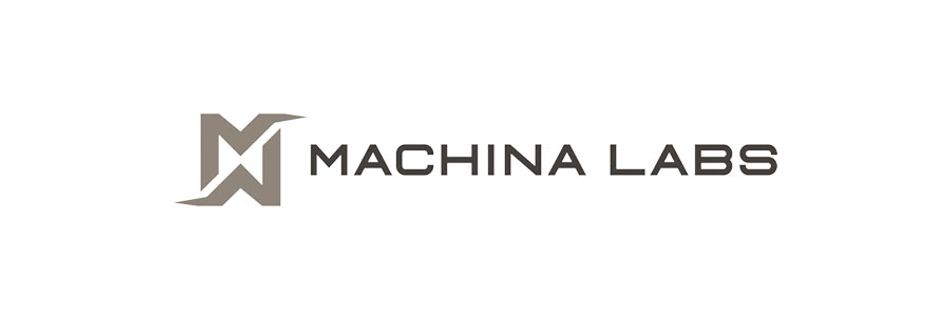Robotics and AI in sheet metal forming
This article explores the role of robotics and Artificial Intelligence (AI) in sheet metal forming. The utilization of AI and automation has accelerated and enhanced the speed and accuracy of centuries-old manufacturing processes.

Image credit: Machina Labs
This article was discussed in our Next Byte podcast.
The full article will continue below.
Introduction
Robots have been part of our assembly lines for decades. They have been helping in processes such as lifting, sorting, welding, and more. Today, robots are increasingly being integrated into the manufacturing processes themselves to handle multiple functions including production, transportation, and packaging of various products. At the same time, AI is being used to further refine the accuracy, efficiency, and speed of these processes. Sheet metal manufacturing has wide-ranging applications from automotive to aerospace, industrial, and consumer products. The ongoing trend toward the integration of AI and robotics is projected to greatly benefit this $300 billion global industry. The global metal fabrication robot market is expected to grow to over $12 billion by 2031[1]. In the future, robots are expected to fully control metal forming processes like material handling, stamping, welding, cutting, folding, and finishing - resulting in almost no human intervention.
What is Sheet Metal Forming?
Sheet metal forming encompasses a range of manufacturing processes used to shape metal sheets into desired parts or products. These processes have an array of applications in industries including automotive, aerospace, construction, consumer electronics, and many others.
Traditional forming workflows require people to manually load sheet metal onto assembly lines for cutting and pressing. Machines and specialized equipment are then used for bending, rolling, or stamping the metal into the desired shape. The process is time-consuming and often requires a chain of manual setups. Moreover, sheet forming is a labour-intensive process and requires highly-skilled workers who understand material requirements as well as how to handle complex machines. In recent years, however, we have seen a decrease in the global skilled labour force which is forcing companies to look for other alternatives.
Processes used to manufacture sheet metal into end-products include:
Bending: In this process, a metal sheet is bent along straight lines like origami to create final desired shapes.
Stretch Forming: This process involves stretching the sheet material over a die to create complex curved shapes.
Roll Forming: This process involves continuously bending the sheet material through a series of rollers to create a specific but simple curved shape or profile.
Deep Drawing/Stamping: This process involves forming a sheet metal blank into a cup-shaped part by using a punch to force the material into a die cavity.
Hydroforming: This process involves forming sheet metal using high pressure fluids against a one-sided tool
Super Plastic Forming: This process involves super heating a sheet of metal and then pressing it against a one-sided tool using gasses.
Spin Forming: This process involves incrementally forming a rotating part over a mandrel, usually manually
The specific application and technique used depends on the material, shape, and requirements of the end product. In the automotive industry, sheet forming is used to produce vehicle body panels, hoods, closures, chassis and frame structures, and other parts.
Similarly, aerospace structural components such as wing skins and fuselage sections are often manufactured using stretch and roll forming methods. In consumer electronics, bending and stamping techniques are employed to produce casings, covers, and enclosures. Construction components such as metal roofs and cladding; medical equipment such as surgical trays, bedding and diagnostic devices; and even many components of furniture are produced via sheet forming. Look around any human-made structure, and sheet metal is likely involved. Needless to say, almost every industry today is in some way linked to the process of sheet forming.
Traditional techniques of sheet forming such as bending, stretch and roll forming, and deep drawing have been virtually unchanged for almost a century. With the introduction of machines and automation, the processes have become faster, but still dominated by expensive tooling, long lead times, and manual supervision. Only recently have processes and progress begun to improve in earnest. Since the beginning of this century, robotics and AI have slowly made their mark on how we view automation. Now, they are being applied to the centuries-old business of sheet forming in order to achieve much higher efficiency and speed.
Robotic Sheet Forming with Machina Labs
Machina Labs is a California-based startup intent on radically changing the sheet forming industry through the use of AI and robotics. Unlike many other startups in the manufacturing industry, Machina Labs creates a comprehensive system of robotics hardware and software.
The Machina Labs robots are equipped with two 7-axis arms, which are synchronized on each side of a large sheet of metal. Anyone who has ever thrown pottery or used Play Dough knows the feeling of simultaneously forming one object by coming at it from two different sides. This is no different. One robot supports the back of the metal sheet, while the other applies pressure and twists and turns to form the metal into the desired shape[2]. Due to the repeatable nature of sheet forming, the use of automation and robots by companies like Machina Labs can tremendously speed up and simplify sheet metal processes.
Machina’s systems autonomously load, form, scan, cut, finish, and unload the final product to manufacture the next one.
Specialized end effector tools are used for bending and rolling the material with speed and precision. The repetitive assembling functions can also be easily automated. Machina’s versatile systems can do the job of numerous people. Currently, the biggest limitation is competing with the throughput of mass production stamping. Early adopters of Machina’s technology are often focused on lower volume products like aircraft and industrial equipment, requiring fewer parts to be manufactured. On the other hand, robotic sheet forming has greater advantages when highly complex, large, customized parts and structures must be manufactured. Machina Labs’ robots combine specialized software, sensors, and metal working tools to produce parts with greater precision and complex designs than was previously possible. Major advantages of robotic metal forming include:
High Quality & Repeatability: Like other applications, Machina’s robotic systems can perform sheet forming operations with much greater precision and repeatability compared to manual techniques. This ensures consistency in meeting the requirement specifications and reduced manufacturing times; making them especially useful in aerospace and automotive sectors where achieving tight tolerances and high quality is critical.
Shorter Lead Times: Since production does not require design-specific tooling or equipment, first parts can be manufactured in hours to days and production can continue 24-7-365, lights out. Improved throughput and significant cost savings allow manufacturers to ramp up products quickly and efficiently.
Flexibility and Adaptability: Robots can be quickly programmed to perform a wide range of sheet forming operations, making them highly flexible and adaptable to different manufacturing environments. They can also be reprogrammed quickly and easily to cater to any changes in design or specifications. Robots are a good solution in combining different functions, which would otherwise require costly changes to complex tooling and/or a large labor force. Flexible movable robots, or FMRs, are currently under research and in use in the industry carrying out functions such as cutting, pressing, bending, and carrying heavy materials at high speeds simultaneously [3,4].
Improved Safety: Automating the process of sheet forming means that robots move the large and heavy metal sheets in and out of machines. This automatically lessens the risk of injury or accident often seen in a manual setup. Moreover, robotic sheet forming can be performed in hazardous or out-of-reach areas, making the task even easier for human operators.
Programming Sheet Forming Robots
Programming robots for sheet forming can be a complex task, requiring both robotics and sheet metal forming expertise. It typically involves creating a path or trajectory for the robot to follow as it shapes the sheet metal. This path must be planned taking into account the shape and size of the sheet metal, as well as any fixtures or end-effectors used to hold it in place during forming. The path must also be optimized to ensure that the robot can perform the operation as quickly and efficiently as possible. Secondly, the programming process also involves setting parameters such as speed, acceleration, and force to achieve the desired shape and minimize defects. This requires careful calibration and testing to ensure optimal performance by the robot.
However, once the robot has been programmed and optimized, it can perform sheet forming operations quickly, accurately, and consistently, resulting in significant productivity gains and quality improvements. A number of robotic manufacturers are already coming up with state-of-the-art solutions to sheet forming [5–7].
Using Artificial Intelligence
Modern robots use an array of AI-backed sensors to analyse real-time data and adjust parameters such as force, speed, and deformation to achieve optimization in the forming process (8). AI also aids in quality control by using machine vision for early detection of defects and deviations from the desired shape during the sheet forming process. Defective parts can be quickly identified and removed from the production line, reducing waste and improving quality. Moreover, AI is being used in optimization of path planning, material selection, and predictive maintenance of the robots and machines in use.
If robots can speed up traditional sheet forming, AI has the ability to accelerate it even further by improving the efficiency, quality, and accuracy of robotic systems, making them even more productive and cost-effective. Manufacturers can leverage the power of AI to stay competitive in an increasingly demanding business.
The Future of Sheet Metal Manufacturing:
Automation will undoubtedly be an important part of the future of sheet metal manufacturing. It has transformed industries and manufacturing around the world and opened doors for greater innovation. Robots are expected to simplify the process of cutting and bending metal sheets while AI will be used to streamline and refine the process even further. Fortune Business Insights forecasts the global industrial robots market to grow to $35.68 billion by 2029[9]. Companies like Machina Labs are at the forefront of this automation revolution which may soon become an essential part of the metal fabrication industry.
Summary
The combination of robots and AI are the future of the global sheet forming industry. Robotic sheet forming offers significant advantages over traditional methods due to its flexibility, precision, and productivity benefits. The once costly and labour-intensive task of traditional sheet forming is slowly being replaced by fast-acting and mobile robots capable of achieving much higher efficiency and lower production times. By carefully selecting materials, optimising processes, and investing in specialized tools and fixtures, manufacturers have an opportunity to speed up production times, achieve greater precision, and provide high-quality products more consistently.
About the sponsor: Machina Labs
Machina Labs is introducing unseen flexibility and agility to the centuries-old manufacturing industry. This unlocks rapid iteration improving the design lifecycle and enabling a higher rate of innovation. Machina Labs’ manufacturing platform combines the latest advances in robotics and AI so great ideas can quickly and affordably turn into reality. Similar to how an experienced craftsman uses a hammer to create sheet metal parts, Machina Labs robots use an extensive array of AI-driven sensors to gather data and incrementally manipulate sheet metal to form the parts. We gather data for every part we run to create a digital twin with all the relevant process information. This provides the most accurate process characterization, and part qualification information for every single unit made.
References
1. Growth Market Reports. Metal Fabrication Robot Market Size, Share & Industry | 2031 [Internet]. 2022 Jan [cited 2023 Mar 4]. Available from: https://growthmarketreports.com/report/metal-fabrication-robot-market-global-industry-analysis
2. With Human Metalworkers Hard to Come By, Robotic Blacksmiths Step Up. Bloomberg.com [Internet]. 2023 Feb 21 [cited 2023 Mar 8]; Available from: https://www.bloomberg.com/news/articles/2023-02-21/nasa-us-air-force-use-robot-blacksmiths-for-automation
3. Heston T. The potential of flexible mobile robots in sheet metal fabrication. The fabricator [Internet]. 2022 Jan 24 [cited 2023 Mar 2]; Available from: https://www.thefabricator.com/thefabricator/article/automationrobotics/the-potential-of-flexible-mobile-robots-in-sheet-metal-fabrication
4. Boesl DBO, Liepert B. 4 Robotic Revolutions - proposing a holistic phase model describing future disruptions in the evolution of robotics and automation and the rise of a new Generation ‘R’ of Robotic Natives. In: 2016 IEEE/RSJ International Conference on Intelligent Robots and Systems (IROS) [Internet]. Daejeon, South Korea: IEEE; 2016 [cited 2023 Mar 2]. p. 1262–7. Available from: http://ieeexplore.ieee.org/document/7759209/
5. Machina Labs. Home | Machina Labs [Internet]. [cited 2023 Mar 4]. Available from: https://www.machinalabs.ai/
6. Fanuc. Automate sheet metal production - Fanuc [Internet]. [cited 2023 Mar 4]. Available from: https://www.fanuc.eu/cz/en/industrial-automation/sheet-metal
7. Metalcraft. Robotic Forming [Internet]. Metalcraft Automation Group. [cited 2023 Mar 4]. Available from: https://mtlcraftautomationgroup.com/robotic-forming
8. Harfoush A, Haapala KR, Tabei A. Application of Artificial Intelligence in Incremental Sheet Metal Forming: A Review. Procedia Manuf. 2021;53:606–17.
9. Fortune Business Insights. Industrial Robots Market Size, Share & Growth Report [2029] [Internet]. 2022 May [cited 2023 Mar 8] p. 160. Available from: https://www.fortunebusinessinsights.com/industry-reports/industrial-robots-market-100360


